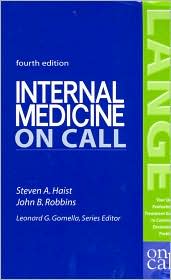-Contents-
I. On Call Problems
1. Abdominal Pain
2. Acidosis
3. Alkalosis
4. Anaphylactic Reaction
5. Anemia
6. Arterial Line Problems
7. Aspiration
8. Bradycardia
9. Cardiopulmonary Arrest
10. Central Venous Line Problems
11. Chest Pain
12. Coagulopathy
13. Coma, Acute Mental Status Changes
14. Constipation
15. Cough
16. Delirium Tremens
17. Diarrhea
18. Dizziness
19. Dyspnea
20. Dysuria
21. Falls
22. Fever
23. Fever in the HIV-Positive Patient
24. Foley Catheter Problems
25. Headache
26. Heart Murmur
27. Hematemesis, Melena
28. Hematochezia
29. Hematuria
30. Hemoptysis
31. Hypercalcemia
32. Hyperglycemia
33. Hyperkalemia
34. Hypernatremia
35. Hypertension
36. Hypocalcemia
37. Hypoglycemia
38. Hypokalemia
39. Hypomagnesemia
40. Hyponatremia
41. Hypophosphatemia
42. Hypotension
43. Hypothermia
44. Insomnia
45. Irregular Pulse
46. Jaundice
47. Joint Swelling
48. Leukocytosis
49. Leukopenia
50. Nausea and Vomiting
51. Oliguria/Anuria
52. Overdoses
53. Pacemaker Troubleshooting
54. Pain Management
55. Polycythemia
56. Pruritis
57. Pulmonary Artery Catheter Problems
58. Seizures
59. Syncope
60. Tachycardia
61. Thrombocytopenia
62. Transfusion Reaction
63. Wheezing
II. Laboratory Diagnosis
III. Procedures
1. Arterial Line Placement
2. Arterial Puncture
3. Arthrocentesis
4. Bladder Catheterization
5. Bone Marrow Aspiration and Biopsy
6. Central Venous Catheterization
7. Endotracheal Intubation
8. Gastrointestinal Tubes
9. Intravenous Techniques
10. Lumbar Puncture
11. Paracentesis
12. Pulmonary Artery Catheterization
13. Skin Biopsy
14. Thoracentesis
IV. Fluids and Electrolytes
V. Blood Component Therapy
VI. Ventilator Management
1. Indications and Setup
2. Routine Modification of Settings
3. Troubleshooting
A. Agitation
B. Hypoxemia
C. Hypercarbia
D. High Peak Pressures
4. Weaning
VII. Therapeutics


